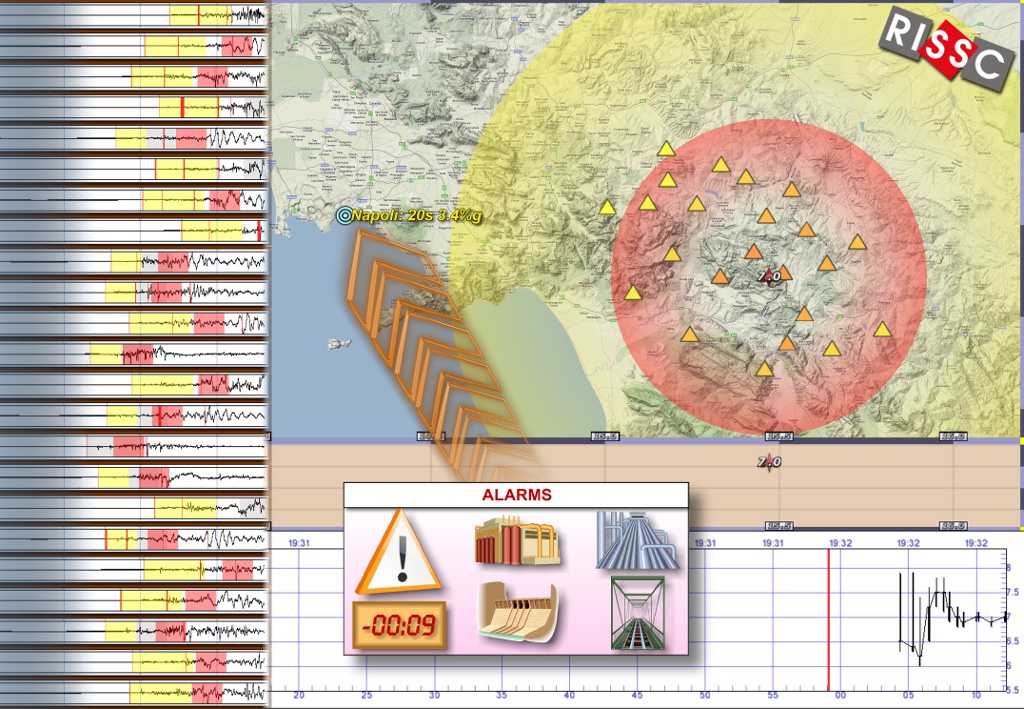PRESTo - PRobabilistic and Evolutionary early warning SysTem
PRESTo - PRobabilistic and Evolutionary early warning SysTem
PRESTo is a free and open source software platform for Earthquake Early Warning (EEW)![]() . It integrates recent algorithms for real-time, rapid earthquake location, magnitude estimation and damage assessment.
. It integrates recent algorithms for real-time, rapid earthquake location, magnitude estimation and damage assessment.
It is a lightweight, graphical application easily installable on either Windows, Linux or Mac. PRESTo is self-contained: it does not require any other seismic software or platform to run, just the ground motion data from a seismic network.
PRESTo is mainly targeted at: managers of seismic networks, civil protections, owners of seismic sensors, companies providing seismic sensors and data-loggers and scientists in the field of seismology and earthquake engineering who are interested in characterizing within seconds (if supported by an adequate network infrastructure) the damaging potential of an occurring earthquake, with the possibility to provide personalized alarm messages to any number of end-users.
The system is in real-time operation on the Irpinia Seismic Network (ISNet)![]() since 2009. Real-time testing is also underway in South Korea on the KIGAM
since 2009. Real-time testing is also underway in South Korea on the KIGAM![]() network (Korean Institute of Geoscience and Mineral Resources), in Romania on RoNet
network (Korean Institute of Geoscience and Mineral Resources), in Romania on RoNet![]() - Romanian Seismic Network (National Institute of Research and Development for Earth Physics) and in Turkey, Marmara region on the KOERI
- Romanian Seismic Network (National Institute of Research and Development for Earth Physics) and in Turkey, Marmara region on the KOERI![]() network (Kandilli Observatory and Earthquake Research Institute).
network (Kandilli Observatory and Earthquake Research Institute).
PRESTo continually processes real-time streams of three-component acceleration data (or optionally velocity data) for P-waves arrival detection. These data are normally streamed from the stations using a SeisComP![]() server via the SeedLink
server via the SeedLink![]() protocol, but they can also be read from files (in SAC
protocol, but they can also be read from files (in SAC![]() format), in order to provide a simulation mode whereby waveforms of past events can be played back into the system. While a (real or simulated) event is occurring, the software promptly performs event detection and provides location and magnitude estimates as well as shaking predictions at target sites.
format), in order to provide a simulation mode whereby waveforms of past events can be played back into the system. While a (real or simulated) event is occurring, the software promptly performs event detection and provides location and magnitude estimates as well as shaking predictions at target sites.
The earthquake location is obtained by an evolutionary, real-time probabilistic approach based on an equal differential time formulation. At each time step, the algorithm uses information from both triggered and not-yet-triggered stations. Magnitude estimation exploits empirical relationships that correlate this parameter to the filtered peak displacement (Pd) measured over the first 2-4 s of P- and S-waves signal. Finally, peak ground-motion parameters at remote sites can be estimated through ground motion prediction equations once location and magnitude are available.
Alarm messages containing the evolutionary estimates of source and target parameters, sent over the internet, can thus reach vulnerable infrastructures at a distance before the destructive waves, enabling the initiation of automatic safety procedures.

RISSC-Lab![]() is a laboratory comprised of researchers from the Department of Physics of the University "Federico II" of Naples (Italy), and AMRA
is a laboratory comprised of researchers from the Department of Physics of the University "Federico II" of Naples (Italy), and AMRA![]() s.c.a.r.l. RISSC-Lab is coordinated by Aldo Zollo
s.c.a.r.l. RISSC-Lab is coordinated by Aldo Zollo![]() , full professor of Seismology.
, full professor of Seismology.
RISSC-Lab carries out research and technological development activities in theoretical and experimental seismology, and is financed through national and international scientific projects.
AMRA s.c.a.r.l., Center of Competence in the field of Analysis and Monitoring of Environmental Risk, is a permanent research enterprise devoted to developing innovative methodologies to approach environmental problems.
The research work behind PRESTo has been supported by the Italian DPC-S5 project. Part of the work has been carried out within the SAFER project (Seismic Early Warning for Europe), founded by the European Community via the Sixth Framework Program for Research. Current development support is provided by Early Warning related Work Packages of these projects: NERA![]() (Network of European Research Infrastructures for Earthquake Risk Assessment and Mitigation, 2010-2014) and REAKT
(Network of European Research Infrastructures for Earthquake Risk Assessment and Mitigation, 2010-2014) and REAKT![]() (Strategies and Tools for Real-Time Earthquake Risk Reduction, 2011-2014). Further development specifically aimed at applications to nation-wide networks has been funded by KIGAM
(Strategies and Tools for Real-Time Earthquake Risk Reduction, 2011-2014). Further development specifically aimed at applications to nation-wide networks has been funded by KIGAM![]() (Korean Institute of Geoscience and Mineral Resources).
(Korean Institute of Geoscience and Mineral Resources).